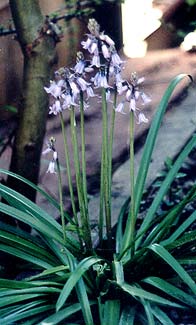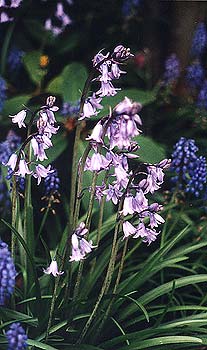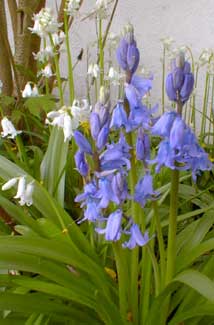
Spanish Bluebells, Scilla, or Squill
"Snug inside I sit & rhyme,
Planning, poem, book, or fable,
At my darling beech-wood table
Fresh with bluebells from the hill."
-Robert Graves
(1895-1985)
(1895-1985)
 Formerly the scientific name was Scilla hispanica, & perhaps because the common name is also Scilla or Squill, it is still quite often listed in bulb catalogs by the former genus name, even though for current nomenclature it is Hyacinthoides hispanica.
Formerly the scientific name was Scilla hispanica, & perhaps because the common name is also Scilla or Squill, it is still quite often listed in bulb catalogs by the former genus name, even though for current nomenclature it is Hyacinthoides hispanica.The squills arrive in our garden in this order: In February Scilla mischtschenkoana 'Tubergeniana' is in full flower, our shortest scilla but with large white flowers. Second comes a long-naturalized white scilla which grows in the deepest darkest driest shadows Hyacinthoides non-scripta'Alba,' lively by March. Soon on its heals is the regular H. non-scripta English Bluebells, liveliest in April. And last of all, but worth the wait, is H. hispanica, Spanish Bluebells, which look exactly like the English except for arriving later & being three to four times taller.
The trick to telling the English from the Spanish bluebells is the Spanish have flowers dangling on all sides of the stem, while the English has most of its flowers on one side of the stems. The Spanish in our yard at least also tends to become a bigger grass clump, & the English has a less upright flower stem. Alas, however, due to decades of hybridization, it's never a 100% certainty which is which, & the Spanish seems to exert its traits over the English so that Spanish bluebells dominate in American gardens.
 Because H. non-scripta & H. hispanica hybridize willynilly, there is probably not a pure specimen of either species in any garden anywhere in the world, & only a few remaining un-hybridized in out-of-the-way meadows in England.
Because H. non-scripta & H. hispanica hybridize willynilly, there is probably not a pure specimen of either species in any garden anywhere in the world, & only a few remaining un-hybridized in out-of-the-way meadows in England.If you do encounter a "pure" English bluebell, it will have a beautiful perfume. The first trait lost in hybridization, tragic to say, is that perfume, as the Spanish bluebell has none of the scent & wherever it has interacted with the English, the English bluebell loses its scent.
The specimen shown at the top of the page was photographed in May when most of the White Squill & the English Bluebells have stopped blooming.
There's a hierarchy of shade ratio for these important shade bulbs, or so it seems in our garden. The white squill H. nonscripta 'Alba' likes the most shade; the regular blue English Bluebell likes brighter shade; & the Spanish Bluebell grows in sunnier locations. All do well in harsh areas that do not get watered.
The clump shown above was a good eighteen inches tall, compared to the earlier bluebells which are no taller than the grape hyacinths, eight or ten inches at the most, & often shorter. The second photo from late April is of a clump only slightly smaller than the first shown. The third photo from mid-April also captures 'Alba' in bloom.